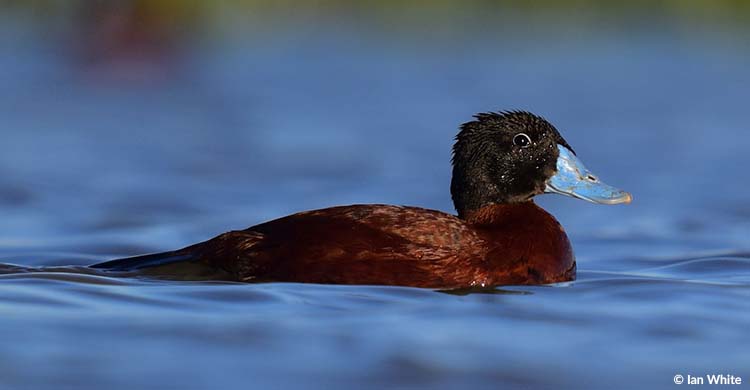Red List Update: A Cause of Relief and Concern for AEWA Species

Maccoa Duck (Oxyura maccoa) has been upgraded from Vulnerable to Endangered in the IUCN Red List © Ian White
Bonn, 14 December 2021 – The rapidly declining population has led the status of the Maccoa Duck, a waterbird species protected under the African-Eurasian Waterbird Agreement (AEWA), to be uplisted to Endangered in the updated IUCN Red List of Endangered Species released last week. Seven other AEWA species were downlisted to lower categories, providing a more hopeful news about the status of these species.
AEWA Executive Secretary Jacques Trouvilliez said: “The classification in a reduced threat category of seven waterbird species is good news. However, the uplisting of the Maccoa Duck is a wake-up call to step up urgent conservation measures for a species at risk.”
With estimated 4,800-5,700 remaining mature individuals of Maccoa Duck (Oxyura maccoa) only, the species has been upgraded from Vulnerable to Endangered. All its three biogeographic populations are decreasing, and the species’ habitat continues to decline. According to estimates of the African-Eurasian Waterbird Census the Southern African population has decreased by 52% between 2002-2018 while the Eastern African population has plummeted by 99% over the same period.
Habitat loss due to the drainage of wetland areas for agriculture is a significant threat to this species. Habitat degradation is also driven by climate change. A scientific study forecasts that almost 90% of the Critical Sites in Africa will become less suitable for waterbirds by 2050 because of climate change. The Maccoa Duck is projected to lose suitable habitats across its entire range, but this loss will be most pronounced in Southern Africa, particularly in Namibia, Botswana, and Zimbabwe. The study coordinated by Wetlands International was published last month.
Habitat deterioration is also of major concern. As the Maccoa Duck feeds mainly on bottom-dwelling invertebrates increasingly contaminated by pollutants, the species is more vulnerable to pollution than other ducks. Rising water levels because of deforestation can severely disrupt the breeding activity of the species.
Also, drowning in gill nets takes a heavy toll.
Urgent and extensive action is required to restore the populations of the species. The AEWA International Single Species Action Plan for the Conservation of the Maccoa Duck, which was adopted 15 years ago, proposes a series of conservation activities still to be implemented such as halting wetland loss in key areas and reducing the use of gill nets in critical sites to prevent accidental entanglement and drowning. Establishing and operationalising an international coordination mechanism to implement this Species Action Plan is a priority.
The seven other AEWA-listed species that have recorded an improved status in the IUCN Red List are the Crowned Cormorant (Microcarbo coronatus), the Chestnut-banded Plover (Charadrius pallidus), the Madagascar Pratincole (Glareola ocularis), the African Skimmer (Rynchops flavirostris), the Damara Tern (Sternula balaenarum), the Armenian Gull (Larus armenicus) and the Razorbill (Alca torda). All species, but one, have been downlisted to the lowest category Least Concern. For five of these species the downlisting is from the upper category Near Threatened while for the Damara Tern it is from the globally threatened category Vulnerable. The Madagascar Pratincole was downlisted from category Vulnerable, but it is still considered Near Threatened.
Most of these downlistings are however the result of improved knowledge and better information rather than genuine status improvement.
Two of those species, the Crowned Cormorant and the Damara Tern are covered by the International Multi-species Action Plan for the Conservation of Benguela Current Upwelling System Coastal Seabirds.
BirdLife International and Wetlands International have collated the data upon which the new assessments are based.
Last updated on 20 December 2021


